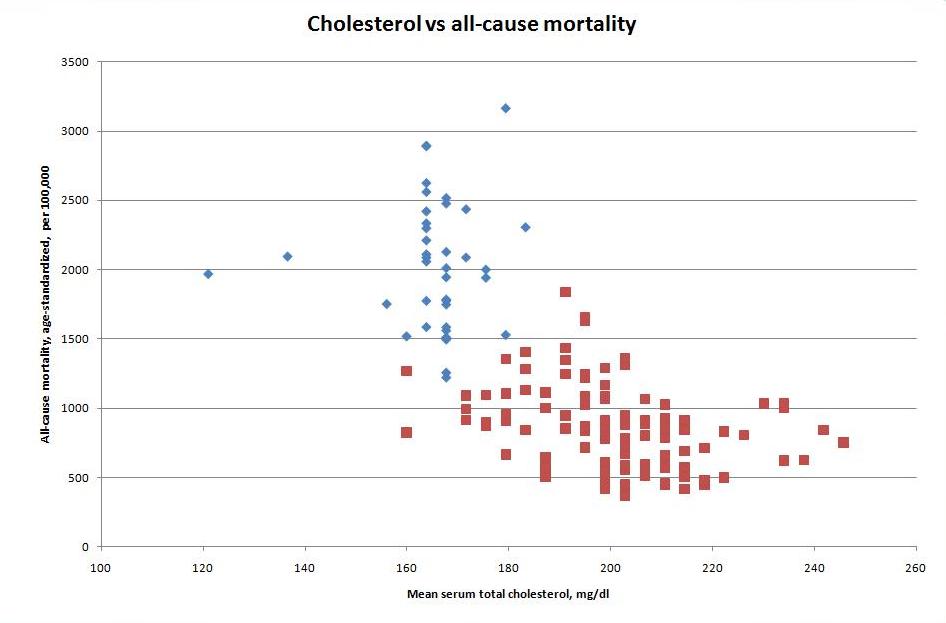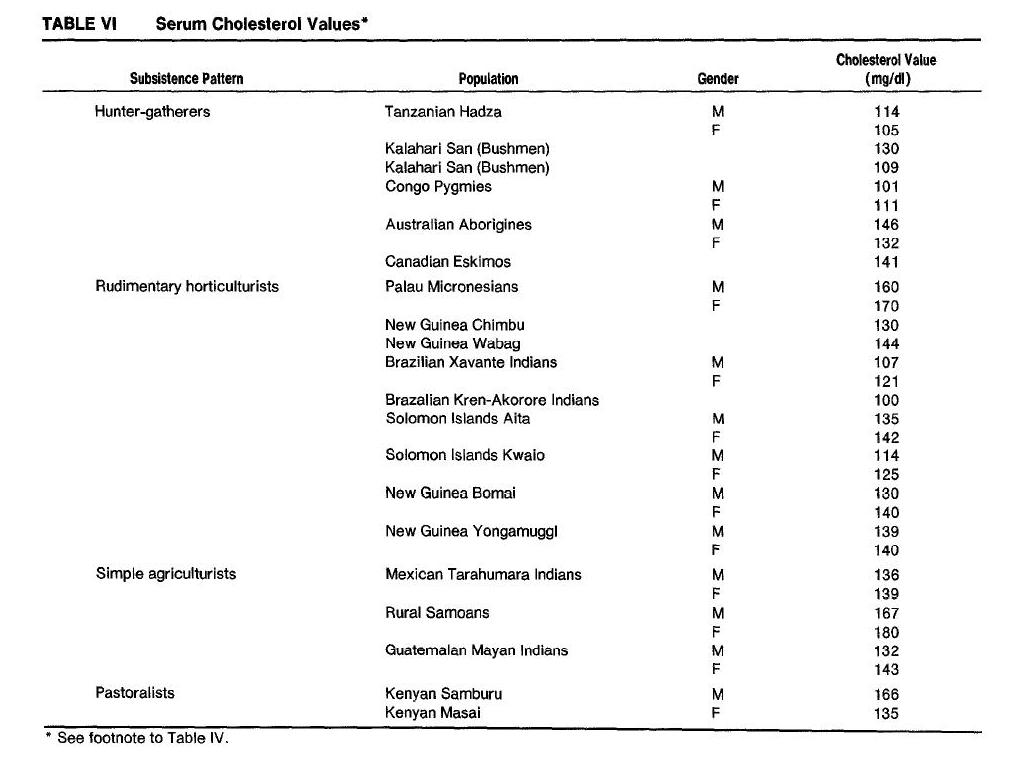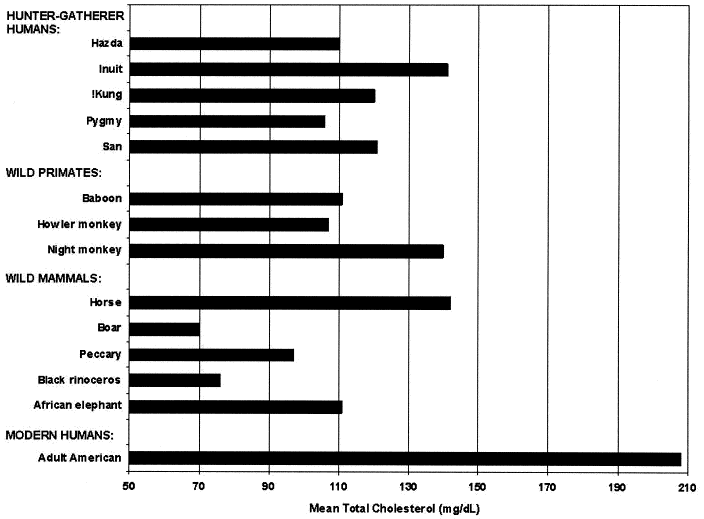So far we’ve looked at serum cholesterol among Eskimos/Inuit (Serum Cholesterol Among the Eskimos and Inuit, July 1, 2011) and !Kung San bushmen (Serum Cholesterol Among African Hunter-Gatherers, July 5, 2011). The Inuit, who live in the Arctic and eat a high-fat low-carb diet, generally had serum TC over 200 mg/dl unless parasitic diseases were common and life expectancy was short. The !Kung San, who live in sub-Saharan Africa and eat more carbs, were below 160 mg/dl and ridden with parasitic diseases and short life expectancy.
I thought I’d wrap up the hunter-gatherer cholesterol series by looking at some tropical populations outside Africa. These peoples may help us evaluate the merit of several explanations that have been put forth for variations in serum cholesterol:
- Genetic differences. Africans tend to have lower cholesterol than non-Africans, wherever they live. Is the difference genetic? Chris Masterjohn believes genetic differences might account for up to a 30 mg/dl difference in TC. Emily Deans suggests LDL receptor variants are the most important alleles.
- Dietary differences such as fat intake. For decades it was said that higher fat diets produce higher TC, and this was the favored explanation for variations in serum cholesterol. However, when these ideas were tested in clinical trials, diet-induced changes in TC were inconsistent.
- Infectious disease burden. Eukaryotic pathogens such as protozoa, worms, and fungi – ie, pathogens that have mitochondria and therefore can metabolize fat and ketones – are often able to take up human lipoproteins from blood and use their fats and cholesterol for their own purposes. This tends to lead to low TC in people with a high burden of parasites. Is parasite burden the key to hunter-gatherer cholesterol levels?
We started this detour (see Did Hunter-Gatherers Have Low Serum Cholesterol?, June 28, 2011) to evaluate the claims of S. Boyd Eaton, Loren Cordain, and collaborators [1], [2], [3], [30]. Their papers tended to promote the following syllogism:
- Diet determines TC.
- Low TC is healthy.
- Hunter-gatherers had low TC.
- Therefore, hunter-gatherer diets are healthy.
So to conclude today’s post, I’ll review: Which of these four theses is supported by the data?
Australian Aborigines
There are a fairly large number of papers on cholesterol levels in Australian aborigines. Unfortunately, the vast majority are from journals, such as the Medical Journal of Australia and the Australian and New Zealand Journal of Medicine, to which I don’t have electronic access.
Therefore I’ll just cite one, a 1957 paper from Schwartz et al in the Australian Journal of Experimental Biology and Medical Science. [31]
This paper looked at aborigines from central Australia. Occupying marginal territory, they were still living a hunter-gatherer lifestyle. But there weren’t many animal foods available, nor seafoods:
The animal fat intake of the Central Australian aborigines from the Haast’s Bluff region involved in this present study is decidedly low when compared with the average intake of white Australians. This low intake of fat results both from a scarcity of fat itself, and also from demands made upon available supplies by native customs. It is likely that the males eat more animal fat than the females, because of their readier access to it after hunting, but the difference is probably small. Wichitty grubs (larvae of several species of Xyleutes moths) are an important source of fat for both women and children, however. Somewhat less than 10 p.c. of the calories in the aboriginal diet is derived from animal fat, i.e. less than one-third of the calories so derived in the white Australian diet (N. B. Tindale, personal communication). [31]
To get even 10% of calories from animal fat, they had to eat a lot of grubs.
So did this low-fat diet produce high or low cholesterol?
Serum cholesterol: … There is no significant difference between the mean values for aboriginal male (217.0 mg/dl) and aboriginal female (207.9 mg/dl). [31]
This is right in line with the levels in Eskimos and Inuit, and in the minimum mortality range of 200 to 240 mg/dl.
Australian aborigines were said to have a mean TC of 146 mg/dl (male) and 132 mg/dl (female) in Eaton et al [1]. Australian aborigines were deleted from the list of hunter-gatherers with low cholesterol in a subsequent Cordain et al paper [2]. I don’t know why this was, but I can say that at least some Australian aboriginal populations had TC over 200 mg/dl.
Kitavans
Kitavans preserved their hunter-gatherer lifestyle until recently, and Staffan Lindeberg and colleagues were able to assess cholesterol levels using modern procedures. They reported serum total cholesterol in men of 4.7 mmol/l (182 mg/dl) and in women of 6.1 mmol/l (236 mg/dl), for a male-female average of 5.4 mmol/l (209 mg/dl). [32]
Health in Kitava was generally good, although life expectancy was only 45 years [33]. Causes of death were infectious disease (notably malaria) and accidents such as drowning and falling from coconut trees.
So we have another tropical, high-carb population with normal (200 to 240 mg/dl) serum cholesterol.
New Zealand Maoris
New Zealand Maoris are probably genetically similar to Australian aborigines and Kitavans. I didn’t survey the literature on New Zealand Maoris. However, I did come across one paper [35] that led me to an interesting 1980 study of Maoris by Dr Robert Beaglehole [36].
The study was quite simple:
The relation between serum cholesterol concentration and mortality was studied prospectively over 11 years in 630 New Zealand Maoris aged 25-74. Serum cholesterol concentration was measured at initial examination in 1962-3 in 94% of the subjects and whether each was dead or alive was determined in 1974. The causes of death were divided into three categories: cancer, cardiovascular disease, and “other.” [36]
Mean serum cholesterol was 5.50 mmol/l (213 mg/dl) among women, 5.82 mmol/l (225 mg/dl) among men, for a population mean of 219 mg/dl.
Dr Beaglehole found that mortality increased as serum cholesterol decreased. Mortality was 40% to 70% higher in Maoris with TC of 160 mg/dl than in Maoris with TC of 260 mg/dl.
The association with cancer mortality was strongest: cancer mortality was 9.6% among the low-TC group (TC < 5.1 mmol/l = 197 mg/dl), 5.8% among the medium-TC group, and 3.5% among the high-TC group (TC > 5.8 mmol/l = 224 mg/dl).
West Malaysian aborigines
Just to balance the above studies I looked for a paper showing low serum cholesterol in an aboriginal population. I found a 1972 paper by Burns-Cox et al studying aborigines in West Malaysia. [37]
Like other traditional populations living active lives, these aborigines were lean and free of heart disease. They ate a high-carb diet:
Coronary heart disease has never been found in Malaysian aborigines. We report the position regarding some of the risk factors usually associated with coronary heart disease in 73 adult aborigine men.
They lived a physically active life on a diet largely of unrefined carbohydrate in the jungles of central West Malaysia. None was obese and blood pressures remained low at all ages. [37]
Their serum cholesterol levels were low – 141 to 156 mg/dl:
While the mean serum cholesterols were low, varying between 141 and 156 mg/100 ml at different ages, the mean fasting serum triglyceride levels of 135 to 164 mg/100 ml were comparable with those found in the West. This may have been due to their high carbohydrate intake. [37]
They were mostly healthy – except that they were infested with intestinal worms and malaria:
The aborigines are thin, extremely fit physically, and for many centuries have lived in the dense hilly jungles of central West Malaysia. They have a high rate of infestation with intestinal worms and malaria but appear well nourished. Their diet consists chiefly of hand-milled rice as a staple, supplemented with cassava, millet, maize, fish, and fruit, nearly all of which they grow or gather themselves. Dairy produce is taken only in very small quantities in the form of reconstituted powdered milk and it is the large volume of starchy foods which accounts for their bulky diet. [37]
Once again, we find that low serum cholesterol is associated with a high burden of eukaryotic pathogens.
Another feature that this population shares with the !Kung San is small stature. Mean averaged 5’1” (155 cm) in height and averaged 105 lb (48 kg) in weight.
Conclusion
Let’s look at the four parts of the syllogism I’ve attributed to Eaton and Cordain:
Diet determines TC. Wrong. It looks like burden of parasites is the major determinant of serum cholesterol in hunter-gatherers and human populations globally.
Low TC is healthy. Wrong. It is associated with high infectious burden, small stature, high mortality, and short lifespan.
Hunter-gatherers had low TC. Some did, some didn’t. So let’s look at a specific claim, this from the classic Cordain-Eaton paper from 2002, “The paradoxical nature of hunter-gatherer diets: meat-based, yet non-atherogenic” (thanks, Rob!):
Over the past 64 y, anthropological research has consistently demonstrated relatively low serum cholesterol and triaglycerol levels among indigenous populations that derive the majority of their diet from animal products. [30]
Wrong. Anthropological research has not consistently demonstrated low serum cholesterol and triglycerol levels from hunter-gatherers, regardless of whether the primary dietary source was animals (Eskimo/Inuit) or plants (Kitavans, Central Australian aborigines). Rather, those with high parasite burdens had low cholesterol, regardless of diet, and healthy populations without parasites had serum cholesterol over 200 mg/dl regardless of diet.
Therefore, hunter-gatherer diets are healthy. True! Except insofar as dietary practices, such as the Eskimo practice of eating raw intestines from recently killed animals, predisposed them to picking up parasitic infections.
Overall I think the data should dispose us to look toward infectious burden, rather than genetics or diet, as the primary determinant of serum cholesterol among hunter-gatherers. If genetic differences influence mean TC among hunter-gatherer populations, it is probably because of evolutionary adaptations to local pathogens, such as the heavy parasite burden in sub-Saharan Africa.
Related Posts
The posts in this series are:
- Did Hunter-Gatherers Have Low Serum Cholesterol?, Jun 28, 2011
- Serum Cholesterol Among the Eskimos and Inuit, Jul 1, 2011
- Serum Cholesterol Among African Hunter-Gatherers, Jul 5, 2011
- Serum Cholesterol Among Hunter-Gatherers: Conclusion, Jul 7, 2011
- Low Serum Cholesterol in Newborn Babies, Jul 7, 2011
References
[1] Eaton SB, Konner M, Shostak M. Stone agers in the fast lane: chronic degenerative diseases in evolutionary perspective. Am J Med. 1988 Apr;84(4):739-49. http://pmid.us/3135745. Full text: http://www.direct-ms.org/pdf/EvolutionPaleolithic/EatonStone%20Agers%20Fast%20Lane.pdf
[2] O’Keefe JH Jr, Cordain L, Harris WH, Moe RM, Vogel R. Optimal low-density lipoprotein is 50 to 70 mg/dl: lower is better and physiologically normal. J Am Coll Cardiol. 2004 Jun 2;43(11):2142-6. http://pmid.us/15172426.
[3] Konner M, Eaton SB. Paleolithic nutrition: twenty-five years later. Nutr Clin Pract. 2010 Dec;25(6):594-602. http://pmid.us/21139123. Full text: http://ncp.sagepub.com/content/25/6/594.full.
[30] Cordain L et al. The paradoxical nature of hunter-gatherer diets: meat-based, yet non-atherogenic. Eur J Clin Nutr. 2002 Mar;56 Suppl 1:S42-52. http://pmid.us/11965522.
[31] Schwartz CJ et al. Serum cholesterol and phospholipid levels of Australian aborigines. Aust J Exp Biol Med Sci. 1957 Oct;35(5):449-56. http://pmid.us/13499168. Full text: http://www.nature.com.ezp-prod1.hul.harvard.edu/icb/journal/v35/n5/pdf/icb195747a.pdf.
[32] Lindeberg S et al. Cardiovascular risk factors in a Melanesian population apparently free from stroke and ischaemic heart disease: the Kitava study. J Intern Med. 1994 Sep;236(3):331-40. http://pmid.us/8077891.
[33] Lindeberg S et al. Age relations of cardiovascular risk factors in a traditional Melanesian society: the Kitava Study. Am J Clin Nutr. 1997 Oct;66(4):845-52. http://pmid.us/9322559.
[35] Walker AR. Cholesterol and mortality rates. Br Med J. 1980 May 31;280(6227):1320. http://pmid.us/7388525.
[36] Beaglehole R et al. Cholesterol and mortality in New Zealand Maoris. Br Med J. 1980 Feb 2;280(6210):285-7. http://pmid.us/7357343. Free full text: http://www.ncbi.nlm.nih.gov/pmc/articles/PMC1600122/?tool=pubmed.
[37] Burns-Cox CJ et al. Risk factors and the absence of coronary heart disease in aborigines in West Malaysia. Br Heart J. 1972 Sep;34(9):953-8. http://pmid.us/4116420.

















Recent Comments